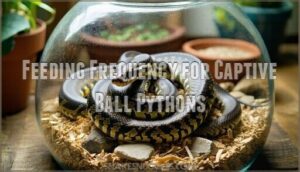This site is supported by our readers. We may earn a commission, at no cost to you, if you purchase through links.

Don’t panic if your snake skips a meal – they’re natural fasters who often refuse food during shedding, breeding season, or temperature changes.
This survival skill helped them thrive in African grasslands where prey wasn’t always available.
However, extended fasting beyond these timeframes requires attention, as it can lead to weight loss, lethargy, or other concerning symptoms that signal when their natural fasting crosses into dangerous territory.
Table Of Contents
- Key Takeaways
- How Long Can a Ball Python Go Without Eating?
- Feeding Frequency for Captive Ball Pythons
- Determining The Appropriate Size of Prey
- Signs of Hunger in Ball Pythons
- How Long Can Ball Pythons Go Without Eating?
- Can a Ball Python Starve Itself to Death?
- Frequently Asked Questions (FAQs)
- How long can a ball python go without food?
- Do ball pythons lose appetite?
- Why is my ball python not eating?
- Do ball pythons eat?
- Do ball pythons refuse food?
- When do ball pythons stop eating?
- How long can a ball python go on a hunger strike?
- What if my ball python hasn’t eaten for 3 months?
- How to tell if a snake is hungry?
- When should I worry about my ball python not eating?
- Conclusion
Key Takeaways
- Your adult ball python can safely fast for 4-6 weeks, while juveniles shouldn’t go beyond 1-2 weeks – this natural ability stems from their slow metabolism and energy conservation skills from the wild.
- Don’t panic if your snake refuses food during shedding, breeding season, or temperature changes – these are normal fasting triggers that can last several months without harming healthy adult pythons.
- Watch for hunger signs like increased restlessness, tongue flicking, glass surfing, and alert postures – these behaviors tell you when your python’s ready to eat again after a fasting period.
- Monitor your snake’s weight and behavior closely during extended fasts – if you notice significant weight loss, lethargy, or fasting beyond the safe timeframes, you’ll need a veterinary consultation to prevent health complications.
How Long Can a Ball Python Go Without Eating?
When your ball python refuses food, understanding fasting duration becomes essential for snake health.
Juveniles can safely fast 1-2 weeks, while adults manage 4-6 weeks without serious starvation risks.
However, python not eating beyond these timeframes signals potential problems.
Ball python fasting often occurs during breeding seasons or stress, but extended feeding strikes require attention.
Monitor your python refusing food carefully – how long fasting continues determines intervention needs.
They can conserve energy by undergoing metabolic rate slowdown.
Feeding Frequency for Captive Ball Pythons
Once you understand your ball python’s fasting habits, you need to establish a proper feeding schedule for ideal health. Regular feeding patterns help prevent both nutritional deficiencies and obesity-related complications.
Juvenile: Every 5 Days
Young ball pythons grow like weeds and need consistent fuel for their development. A feeding schedule every 5-7 days supports their rapid growth rate and nutrition needs.
Here’s what to watch for:
- Weight monitoring weekly prevents python not eating issues
- Snake behavior changes signal feeding readiness or problems
- Ball python fasting beyond two weeks requires attention
- Reptile appetite loss might indicate health concerns
Adjust timing based on your snake’s response—some juveniles thrive on this schedule while others need slight modifications. To guarantee proper nutrition, consider prey selection guidelines for a balanced diet.
Adult: Every 7-10 Days
Once your ball python reaches adulthood, you’ll shift to feeding every 7-10 days. This schedule supports their slower metabolism while maintaining ideal python health.
Consider these adult care essentials:
- Prey size: Match the snake’s thickest body section
- Quality nutrition: Choose high-protein, low-fat options like rats
- Safety first: Use pre-killed frozen/thawed prey
Adult feeding schedules differ substantially from juvenile needs. Your mature ball python’s digestive system works more efficiently, requiring less frequent meals. Monitor your python’s body condition—overfeeding leads to obesity faster than you’d expect.
Adjust Based on Appetite and Behavior
Tailor your ball python’s feeding schedule to its individual appetite monitoring and snake behavior. Watch for feeding cues like increased activity and tongue flicking, which signal readiness to eat.
Health indicators like consistent weight and alertness suggest proper nutrition. Some pythons show distinct fasting patterns – adjust accordingly rather than forcing strict schedules for ideal reptile feeding habits.
Understanding the ball python temperament is vital for creating a suitable environment that promotes healthy eating habits.
Avoid Overfeeding and Underfeeding
Finding the right balance prevents health problems.
Overfeeding causes obesity and liver disease, while underfeeding leads to malnourishment and weakened immunity.
Stick to proven feeding guidelines: juveniles every 5-7 days, adults every 7-14 days.
Monitor your python’s weight management closely—visible ribs signal underfeeding, while fat deposits indicate overfeeding.
Proper snake nutrition through consistent feeding schedules keeps your ball python healthy and prevents dangerous feeding strikes.
Determining The Appropriate Size of Prey
When feeding your ball python, you’ll want to choose prey that weighs no more than 15-20% of your snake’s total body weight.
Getting the size right prevents both obesity from overfeeding and malnutrition from underfeeding, keeping your python healthy and thriving.
No More Than 15-20% of The Snake’s Body Weight
Getting the prey size right prevents digestive stress and maintains your ball python’s health. Proper food proportions guarantee healthy snake nutrition without risking python weight loss from inadequate feeding or obesity from overfeeding.
- Weigh your snake regularly – Use digital scales for accurate weight monitoring
- Calculate 15-20% of body weight – This determines maximum prey size limits
- Choose appropriately sized rodents – Match prey to your snake’s feeding limits
- Monitor feeding response – Healthy pythons should consume prey within recommended proportions
- Adjust as needed – Growing snakes require updated food proportions based on current weight
Following reptile feeding guidelines prevents both malnutrition and excess weight gain. Snake fasting duration often correlates with improper prey sizing, so maintaining correct food proportions supports consistent ball python health and natural snake feeding habits.
Understanding ball python food options is vital for providing a balanced diet.
Overfeeding Can Lead to Obesity and Health Complications
Consistent overfeeding turns your ball python into a couch potato with serious health risks.
Obesity increases chances of fatty liver disease and cardiovascular problems, while reducing activity levels and lifespan.
Regular weight monitoring and proper feeding limits prevent these complications.
Stick to appropriate prey sizes—your snake’s health depends on smart weight management, not supersized meals.
Underfeeding Can Result in Malnourishment and Reduced Immune Function
Beyond mere feeding frequency, inadequate nutrition creates a domino effect of health problems in your ball python.
Snake malnutrition weakens your pet’s defenses against disease and infection.
Malnutrition risks include:
- Suppressed immune system – making your python vulnerable to respiratory infections and parasites
- Muscle wasting – causing visible weight loss and reduced activity levels
- Poor wound healing – extending recovery time from injuries or shed complications
- Stunted growth – particularly dangerous in juvenile pythons during critical development phases
Health monitoring through regular weighing prevents starvation effects before they become life-threatening.
Do Not Feed Prey Larger Than The Snake’s Head
Unlike underfeeding risks, prey size directly impacts snake safety during meals.
Never offer prey larger than your python’s head circumference—this feeding tip prevents regurgitation and esophageal injury.
Oversized meals create digestion issues and stress your snake’s system.
Following proper reptile feeding guidelines guarantees healthy python feeding habits.
| Snake Age | Head Size Rule | Safety Risk |
|---|---|---|
| Juvenile | Slightly smaller than head | Choking/injury |
| Adult | Match head circumference | Regurgitation |
| Senior | Conservative sizing | Digestive stress |
Smart meal planning means visual assessment before every feeding session.
Monitor Weight Regularly
Regular weight tracking serves as your best tool for monitoring snake nutrition and detecting potential health issues early.
Weekly weigh-ins help you adjust feeding schedules based on your python’s body weight changes, guaranteeing proper nutrition without overfeeding.
Consistent weight monitoring allows you to spot concerning weight loss before it reaches dangerous snake starvation threshold levels.
Accurate snake weight measurements require a reliable snake weight scale to guarantee the health of your pet, ensuring proper care through regular monitoring and adjustments to maintain optimal pet health.
Signs of Hunger in Ball Pythons
You’ll notice several clear signs when your ball python is ready to eat.
These behaviors include increased restlessness, frequent tongue flicking to detect prey scents, glass surfing along enclosure walls, head bobbing movements, and an alert hunting posture.
Restlessness
When your ball python displays restless behavior, it’s likely signaling hunger and ready for its next meal.
This snake anxiety manifests through increased activity that breaks their typical calm demeanor.
- Pacing around the enclosure perimeter
- Attempting to climb glass walls or escape
- Environmental stress from irregular feeding schedules
- Tank enrichment disruption as they search for food
Tongue Flicking
You’ll notice increased tongue flicking when your ball python’s hunting instincts kick in.
This flicking behavior helps them detect chemical signals and thermal detection from potential prey through specialized sensors.
Watch for rapid tongue movement – it’s your snake’s way of "tasting" the air for food.
However, excessive flicking combined with restless snake sensing behaviors often signals hunger in ball pythons during snake fasting periods.
Understanding ball python behavior is essential for recognizing these patterns.
Glass Surfing
Glass surfing behavior signals stress in ball pythons during fasting periods.
When your snake repeatedly slides against enclosure walls, it’s often due to inadequate tank size or insufficient hiding spots.
This repetitive movement can cause glass damage over time.
Common stress causes include:
- Enclosure too small – upgrade to appropriate dimensions
- Missing hide boxes – provide secure retreats on both sides
- Environmental disturbances – reduce handling and noise
Proper surfing prevention involves addressing these housing issues rather than assuming it’s normal snake behavior during feeding strikes.
Head Bobbing
When you spot your ball python making sharp, repetitive head movements, you’re witnessing classic Head Bobbing behavior.
This snake behavior often signals hunger, though it can also indicate stress or territorial responses.
Watch for these quick, jerky motions paired with increased tongue flicking – they’re key feeding cues that suggest your python is ready for its next meal and actively searching for prey.
Body Posture
Hungry ball pythons often display distinctive posture changes that reveal their appetite.
You’ll notice your snake stretching upward with an alert, raised head position while maintaining tight coil patterns.
This posture analysis differs from normal resting positions, showing increased body alignment and tension.
When your snake’s refusing food despite these behaviors, consider snake appetite stimulation techniques or monitor for potential snake health issues affecting feeding responses.
How Long Can Ball Pythons Go Without Eating?
You might worry when your ball python skips a meal, but these reptiles can actually go quite a while without food.
The timeframe varies substantially based on your snake’s age and size, with juveniles lasting 1-2 weeks and adults managing 4-6 weeks safely.
Juvenile: 1-2 Weeks
Juvenile ball pythons can safely fast for 1-2 weeks before health risks emerge.
Young pythons have limited fat reserves compared to adults, making extended food refusal more concerning.
During snake growth periods, consistent juvenile feeding every 5-7 days supports proper development.
If your young python shows persistent food refusal beyond two weeks, monitor weight closely and consider veterinary consultation to prevent malnutrition.
Adult: 4-6 Weeks
Adult ball pythons can safely endure fasting durations of 4-6 weeks without serious health risks.
Their adult nutrition reserves and slower metabolism allow extended feeding patterns compared to juveniles.
However, watch for concerning snake behavior like lethargy or rapid weight loss.
A python feeding strike exceeding one month requires veterinary attention, as the snake starvation threshold approaches and reptile fasting periods become dangerous.
Duration Depends on Age, Size, and Other Factors
How do environmental conditions affect fasting duration in your ball python? Snake health, age factors, and size limits substantially influence how long your python can safely refuse food during a feeding strike.
- Juvenile pythons (under 1 year) tolerate shorter reptile fasting periods than adults
- Temperature stress can trigger python fasting reasons and reduce safe duration
- Body condition determines individual tolerance to snake refusing food episodes
- Seasonal cycles naturally affect ball python behavior and appetite patterns
- Hydration levels directly impact survival during extended python feeding strike periods
Understanding proper ball python food nutrient requirements is vital for maintaining healthy health during these periods.
May Go Downhill Fast if Not Addressed Promptly
When starvation risk escalates, your snake’s health can deteriorate rapidly without intervention.
Snake refusing food for extended periods triggers weight loss and weakened immunity.
Health monitoring becomes critical—watch for lethargy or unusual snake behavior.
Address feeding issues promptly through environmental adjustments or veterinary consultation to guarantee effective starvation prevention and recovery.
Can a Ball Python Starve Itself to Death?
While ball pythons can fast for months without dying, they won’t typically starve themselves to death in healthy captive conditions.
Your snake’s refusal to eat is usually temporary and linked to natural behaviors like breeding cycles or shedding periods.
Occasional Fasts Are Not a Cause for Concern
Don’t panic if your ball python skips a meal or two. These natural fasting periods happen regularly and usually indicate normal python behavior rather than health problems.
Monitor your snake’s weight and watch for concerning signs during food refusal periods. Understanding ball python behavior is essential for identifying potential issues.
Key warning signs during fasting behavior include:
- Significant weight loss – More than 10-15% of body weight
- Lethargy or reduced movement – Snake becomes unusually inactive
- Poor shedding cycles – Incomplete or stuck shed indicates declining snake health
- Extended food refusal – Fasting beyond 6-8 weeks increases starvation risks and requires recovery time assessment
May Refuse Food During Breeding Season or Shedding Cycles
During breeding season and shedding cycles, your ball python’s hormones trigger natural food refusal patterns.
These breeding fasts and appetite changes reflect normal snake behavior rather than health issues.
However, monitor weight carefully during extended fasting patterns.
| Cycle Type | Duration | Monitoring |
|---|---|---|
| Breeding Season | 2-4 months | Weekly weights |
| Pre-Shed | 1-2 weeks | Visual checks |
| Post-Shed | 3-7 days | Resume feeding |
| Seasonal Changes | 1-3 months | Vet consultation |
| Stress Response | Variable | Address causes |
Can Go Lengthy Periods Without Eating in The Wild
In the wild, ball pythons master survival tactics through natural fasting patterns.
Wild-caught specimens demonstrate remarkable snake metabolism adaptations, surviving lengthy periods without food during seasonal changes or brumation.
Their natural food refusal behaviors reflect evolved survival mechanisms, with some documented fasting durations extending months.
This prolonged fasting ability showcases their incredible resilience in harsh environments.
Frequently Asked Questions (FAQs)
How long can a ball python go without food?
Remarkably, one ball python holds the record for surviving 382 days without food.
Your healthy adult ball python can safely fast for 4-6 months, while juveniles should eat within 1-2 weeks to maintain proper growth.
Do ball pythons lose appetite?
Yes, ball pythons frequently lose their appetite. You’ll notice they refuse food during breeding season, shedding cycles, temperature changes, or stress from enclosure modifications, making appetite loss quite normal behavior.
Why is my ball python not eating?
Ball pythons refusing food isn’t uncommon – stress, incorrect temperatures, shedding cycles, or seasonal breeding patterns often trigger appetite loss. Check your husbandry conditions first, then monitor closely.
Do ball pythons eat?
Ball pythons are natural predators that actively hunt and consume prey in the wild.
You’ll find they primarily eat small mammals like rodents, birds, and occasionally other reptiles, using their powerful constriction method to subdue meals.
Do ball pythons refuse food?
Frequently, finicky feeders frustrate first-time owners when their ball pythons refuse meals.
You’ll find this behavior completely normal, especially during breeding seasons, shedding cycles, or temperature changes.
Don’t panic if your snake skips a meal or two.
When do ball pythons stop eating?
Your snake typically stops eating during breeding season (fall/winter), before shedding, when stressed, or if temperatures drop. They’ll also refuse food when sick, ovulating, or simply being picky eaters.
How long can a ball python go on a hunger strike?
Your ball python can hunger strike for several months without serious health concerns.
Healthy adults often fast 4-6 months, especially during breeding season, though you’ll want veterinary consultation if it exceeds that timeframe.
What if my ball python hasn’t eaten for 3 months?
Like knights of old skipping their feast, you shouldn’t panic yet.
Three months is concerning but manageable for adult ball pythons.
Monitor weight closely, check temperatures, and consider veterinary consultation if weight loss exceeds 15% or behavior changes markedly.
How to tell if a snake is hungry?
You’ll notice your ball python actively exploring its enclosure, tongue-flicking more frequently, and showing increased alertness around feeding time.
A hungry snake typically becomes more responsive to movement and may even approach when you open the enclosure, which can be an indication of its increased alertness.
When should I worry about my ball python not eating?
You should worry if your ball python hasn’t eaten for over a month, shows weight loss, displays unusual behavior, or appears ill. Seek veterinary attention immediately.
Conclusion
Amazingly, understanding how long can a ball python go without eating isn’t rocket science—adults handle 4-6 weeks while juveniles max out at 1-2 weeks.
You’ve learned that natural fasting during shedding or breeding is normal, but extended periods require monitoring.
Watch for hunger signs like restlessness and tongue flicking, then adjust feeding schedules accordingly.
Remember, your snake’s age, size, and health determine their fasting tolerance, so stay observant and responsive to their needs.
- https://www.webmd.com/pets/feeding-a-ball-python
- https://community.morphmarket.com/t/feeding-schedule-for-current-age-weight/46373
- https://www.xyzreptiles.com/ball-python-care/
- https://www.reddit.com/r/ballpython/comments/w3kkhk/how_often_do_you_guys_feed_your_adult_ball/
- https://reptifiles.com/ball-python-care-guide/ball-python-feeding/



















